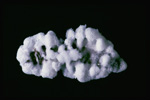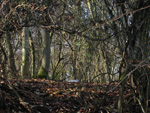The ecology of anamorphic entomopathogenic fungi: investigating the occurrence and structure of natural populations
Poor understanding of the population biology of anamorphic may well be acting as a barrier to the development of new and more effective ways of exploiting them for biological control. It also impacts on bio-prospecting and risk assessment studies for fungal biocontrol agents. In work done some time ago (Chandler et al., 1997), we sampled the occurrence of entomopathogenic fungi in soils from an arable field, hedgerows and mature woodlands in Warwickshire using an ‘insect bait’ technique. We found that fungi were isolated from significantly more samples of soil from woodland and hedgerows than the arable field. There was also a significant different in the occurrence of entomopathogenic fungi between the four woodlands.
In the last few years, we have been investigating the structure of natural Beauveria populations sampled in England, inspired by the insights of Steve Rehner in the US on Beauveria phylogeny and Mike Bidochka’s research in Canada on the relationship between habitat type and fungal population structure.
Isolates of Beauveria (and other entomopathogenic fungal species) were obtained from c. 4000 soil samples collected from 18 woodlands or grass pastures in a broad transect from southwest to mid-west England. The frequency of occurrence of B. bassiana and other species increased with more northerly latitudes. Multi locus sequence data were then obtained for a total of 120 Beauveria isolates selected from the various sample locations.
The isolates grouped into three deep seated clades. The clades showed a statistically significant association with habitat type: clade 1 (currently referred to as B. bassiana) was associated more with grasslands than expected, while clades 2 and 3 (currently referred to as B. bassiana and B. brongniartii) were associated more with woodlands than expected.
In a second experiment, fungal isolates were obtained from c. 1000 soil samples collected from a connecting field complex on the Warwick HRI farm, comprising an arable crop, a field of ‘set aside’, a field of permanent grassland, and hedgerows. The same population structure was evident as in the first experiment, with hedgerow acting as a substitute for woodland. Thus clade 1 was associated more with the open field environments than expected, while clades 2 and 3 were associated more with hedgerow than expected.
This information will help us re-evaluate what we know about Beauveria in terms of its evolution, phylogeny and ecology. In turn we can use this information to help inform biocontrol strategies (for example, it may not make sense to apply a Beauveria biopesticide into a habitat for which it is not well adapted, for example applying an isolate from a ‘woodland’ clade into an open field). But many questions remain about the ecology of Beauveria and other anamorphic entomopathogenic fungi, which together make up a group of fascinating natural enemies. We know little about their ecosystem function – for example are they ecologically obligate pathogens? What are the determinants of population structure and population dynamics? How does virulence evolve? And can we develop a meaningful species definition? Finally, can we use ecology to develop a theoretical framework for predicting environmental(non target) impacts of biocontrol releases in the field?
Selected reference:
CHANDLER, D., HAY, D. B. & REID, A. P. (1997). Sampling and occurrence of entomopathogenic fungi and nematodes in UK soils. Applied Soil Ecology, 5, 133-141.

Beaveria bassiana

Woodlands are an important habitat for entomopathogenic fungi
